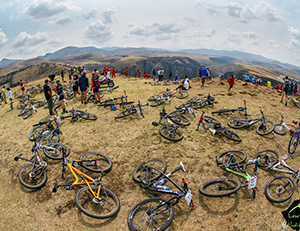Mozambique
A visit to Mozambique makes you feel like you’re far from South Africa, especially if you go beyond the popular southern coast of the country.
Where you can go will depend on how much time you have. If not a lot, drive to Ponta Malongane (stay at Tartaruga Maritima) or Ponta do Ouro. If you have a week or more, head further north to Xai-Xai, Tofo or Vilanculos. Allow plenty of travel time to reach these and other places further up the coast.
To really get away, head for the Gorongosa National Park. “Hike halfway up Mount Gorongosa to the forest and look for the green-headed oriole, a beautiful and rare bird,” says Toast Coetzer at Go! magazine.
Erns Grundling, also from Go!, recommends going for an early morning sail or paddle on Lake Bilene to Villa N’Banga and the Baba Laria restaurant for a decadent breakfast of a coconut cocktail (in a coconut) and pancakes.
“If you visit Xai-Xai, poke around the derelict and desolate Chongoene Hotel that last saw guests before the civil war,” he continues. “My favourite spot is Zona Braza at Praia de Chizavane, 40 kilometres north of Xai-Xai. It’s a small lodge with thatched chalets in a coastal forest perched on a dune. Grab a deck chair, have a Mozambican 2M (‘dosh-em’) beer and look out across the waves, knowing the chef is preparing a large plate of prawns for dinner.”
Grundling encourages visitors to support local entrepreneurs by buying cashew nuts and peri-peri sauce from roadside stalls and vendors.
Botswana
Botswana, just like South Africa and Namibia, is a land of contrasts, Grundling says. “You can pitch your tent on the Makgadikgadi Pan at Kubu Island and walk among the baobabs, imagining you’re The Little Prince. Or you can glide along narrow channels in a mokoro and spot elephant or lechwe.”
But his number one activity in Botswana, Grundling says, will always be a sunset cruise on the Chobe River, specifically around Sedudu Island. “You’ll see animals by the dozen or most likely in the hundreds, like elephant families that link trunk and tail to cross the river in a train.”
Coetzer recommends a hike up the Goo-Moremi Gorge to the vulture colony lookout point, sunset on the Sowa Pan near Nata, and searching for lion, leopard and elephant in the hardwood forest around the Xakanaxa camp in Moremi nature reserve.
Tyson Jopson of Getaway Magazine recommends Savuti. “I can’t rave about this place enough,” he says. “It’s not unknown per se, but sometimes the crowds are right. If you go to Chobe National Park and don’t spend at least a day driving the Savuti channel, then you’re missing out. Big time. The wildlife here is incredible. Go in May to avoid the masses, but still have good sightings.”
He also recommends the isolated Gcwihaba Caves. “It’s a huge cave network in western Botswana, beneath dry Kalahari landscape. There are no formal campsites – there were plans to build some when I was there – and you pay a guide to take you through the caves. Getting there is the big challenge: 118 kilometres of deep sand track separate this natural wonder from the uninitiated. It’s 4x4 bliss!”
Lesotho

Where Botswana and Mozambique are about wildlife, plains, sea and swamps, the Mountain Kingdom is for those who love the peaks, snow pilgrims, bike riders and adventure seekers. It’s also close to Johannesburg, Bloemfontein and Pietermaritzburg, which gives you even more reason to visit.
The soon-to-be-tarred Sani Pass is a wonderful way to arrive in Lesotho, with spectacular views all along the way. Head north to the Afriski Mountain Resort, where you can ski, snowboard and bumboard in winter. In the other seasons the resort offers motorcycle tours, mountain bike riding, 4x4 trails, trout fishing and hiking, to name but a few of many activities. From Afriski a two-hour drive can take you to Lesotho’s only five-star hotel, the highly regarded Maliba Lodge. Here guests can enjoy fairy tale vistas and exceptional food.
In the centre of Lesotho you’ll find the Maletsunyane Falls near Semonkong, where the brave can abseil down a sheer 200m cliff. These falls are the second highest in Africa. Christian Schmidt, organiser of the annual Lesotho Sky Mountain Bike Race recommends driving or riding the very scenic road between Semonkong and Roma, especially to those who enjoy alpine-style (tarred) mountain passes.
To get to the well-known Malealea Lodge from Roma doesn’t take more than 90 minutes. Here visitors and guests can embark on long and short pony treks.
With acknowledgement to SPAR Savour Magazine.
Don’t go without
- Whichever of our neighbours you choose to visit next, don’t leave home without long sleeves and repellant to protect against those nocturnal insects with vampire tendencies. (They say garlic and rum also work.) Trousers and long-sleeved shirts with UV protection also protect you against sunburn. Add SPF 40 sunscreen, a hat and sunglasses with a band that will keep you from losing them. When visiting Lesotho in winter, pack for possible emergencies, such as being stranded in -15°C conditions.
- Take an attitude that refuses to pay spot fines for fabricated traffic “offences”. Remember to pack passports, reflective triangles and vest, your vehicle’s registration documents and any other official requirements your destination country might have. A 4x4-vehicle is virtually essential for extensive travel in these three countries.
- Learn a few phrases in the local language: Portuguese in Mozambique, Sesotho in Lesotho and Setswana in Botswana.
- Don’t drive on Mozambique’s beaches unless you absolutely have to and only where this is allowed. Consult widely and then compile a list of other items that have to go with you. Where possible, inform people at your destination when you will arrive. Use good (paper) maps and a GPS.